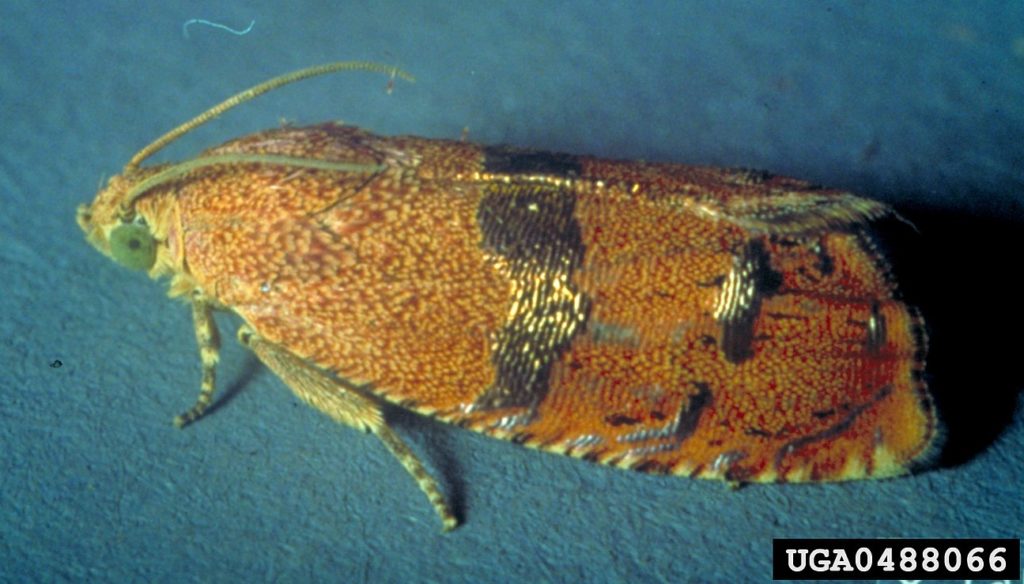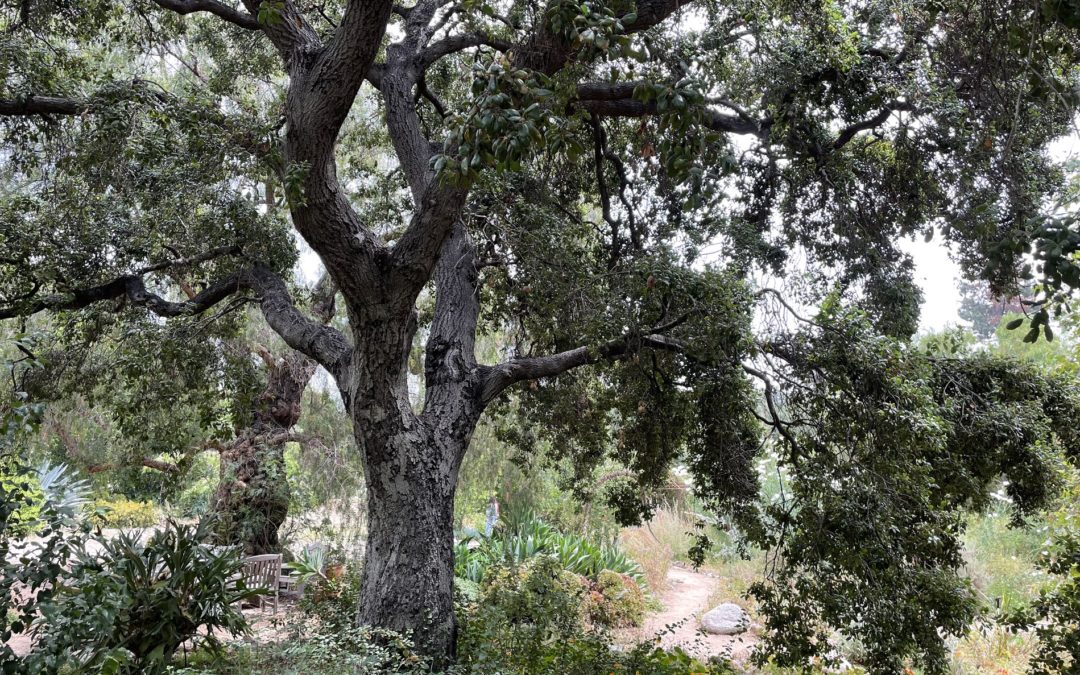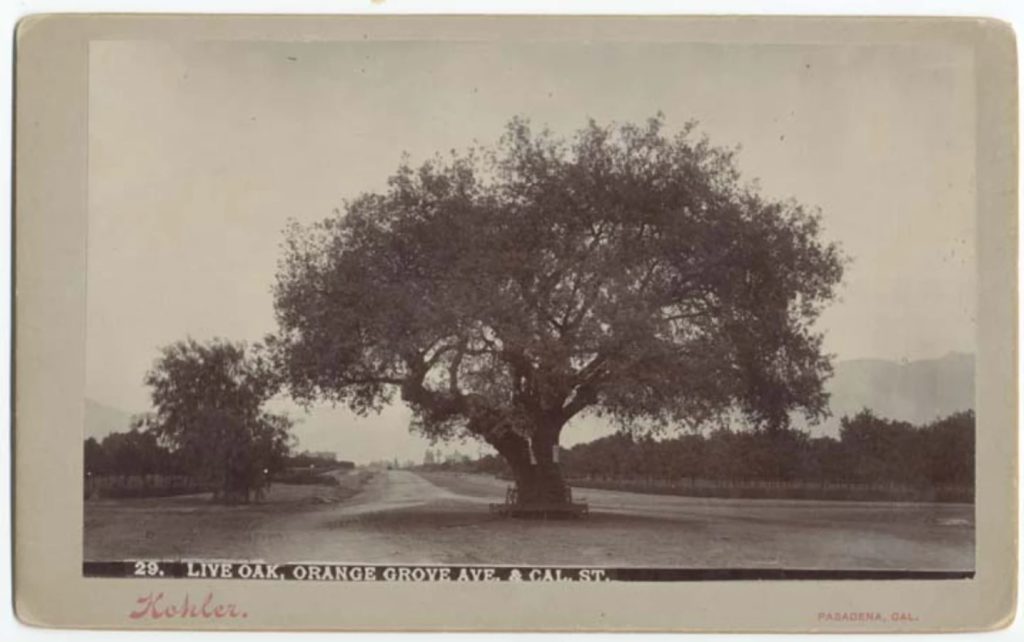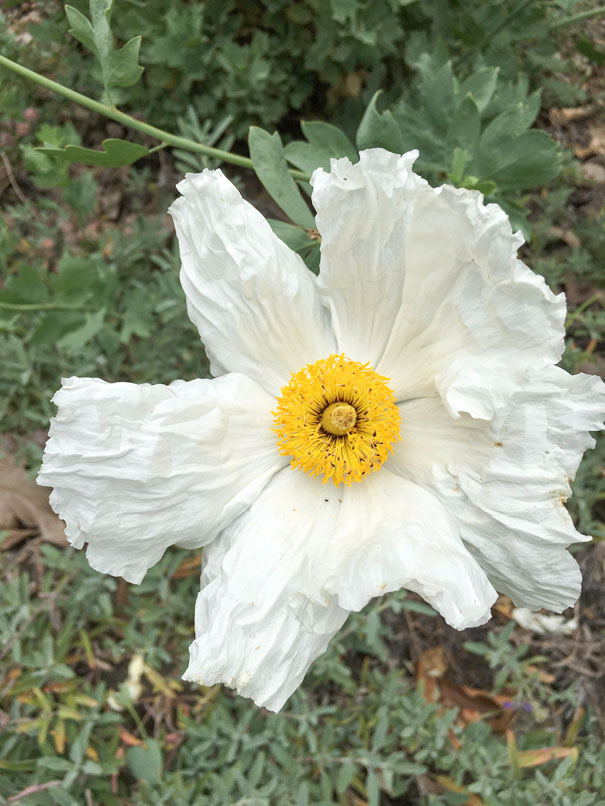Arlington, Overworld is a monthly series devoted to the ecology, history, horticulture, and biology of plants in Arlington Garden. The “overworld” is the highest-level map of a videogame showing mountains, forests, kingdoms, dungeons, and treacherous wastes. Not part of normal gameplay, the overworld facilitates progression from level to level — A.J. Jewell.
Coast live oak: Quercus agrifolia, encina/encino (Spanish), weť (Tongva)
Origin: California Floristic Province, coastal regions up to Mendocino
Mature size: trees often wider than tall: 30-60 ft. tall, 40-70 ft. wide
Gardening notes: evergreen, cupped, holly-shaped leaves; develops multiple trunks with space and time; trees live for 250+ years with much older specimens recorded; tolerant of hot fires; keystone species in oak woodlands and an excellent habitat plant; avoid changing grade under the tree canopy.
THE COAST LIVE OAK pictured above is over 100 years old. It was one of 8 trees at Arlington Garden when it was founded in 2005, and the tree looks largely unchanged since that time. Of course, if you had been a rock or a mountainside during its early years, with your unblinking mineral eyes you would have seen branches fork like lightning across the sky and trunks explode upwards. Despite looking unchanged, coast live oaks like this one undergo relatively rapid growth during maturation, growing to 40 ft in a measly 20 years.
ACORNS AND FIRE
Older oaks of a variety of species produce acorns in abundance, providing a dietary staple for indigenous communities throughout California. These communities maximised production of acorns by using small, frequent fires to clear the brush under oaks, which made it easier to harvest acorns, keep other plants from encroaching, and prevent pests and diseases (Anderson).
Indigenous communities harnessed — and continue to harness — these small fires in sophisticated ways. Fascinatingly, burning was timed to exploit weaknesses in the life cycle of detrimental insects: the filbertworm, Cydia latiferreana, is an acorn pest that spends part of its life pupating in the leaf-litter underneath oaks before remarkably transforming into a wholly unremarkable-looking moth. Indigenous burning of undergrowth in the Fall killed filbertworms in their pupal stage, protecting the acorn harvest (Anderson).

Pictured: unremarkable but adorable Cydia latiferreana. Credit: Larry R. Barber, USDA Forest Service.
RELIABLE INDICATORS
Beginning at the southern border and ending on the North Coast, the Spanish mission system in California followed the range of the coast live oak. This is probably not an accident, since the large, grey and green gnarled oaks – called “encinas” by the Spanish, using their name for the European holm oak Quercus ilex – frequently grow in deep soils along the coasts [USDA]. Franciscan missionaries were aware that coast live oaks were more-or-less reliable indicators of arable soil. And missions, which used the standard European farming practices of the time, required it.
As the friars crept up the coast, they encountered open woodlands and savannas dominated by gigantic oaks. In 1769, the Franciscan missionary Fray Juan Crespí described “large tablelands” with an open understory of “fine grasses” and “big tall live-oaks” – so big that he had never seen larger – around present-day Santa Barbara. These landscapes were likely the result of centuries of continuous care, incorporating frequent burning by the indigenous people who lived there [Mensing]: Fray Juan Crespi was praising the work of the Chumash, intentionally or not, when he marveled at the great trees near Santa Barbara.
The missions needed farmland. They also sought indigenous people to work, very often against their will, to convert and indoctrinate, and treat like inhuman clay to be shaped. Terrible and ironic as it may be, the presence of a coast live oak savanna, with a “park-like” understory [Mensing] and ample acorns, would have been an indicator of farmland and an indigenous community to convert.
THE SPECIAL RELATIONSHIP
Paleoecologist Scott Mensing reports that there is no evidence that Native Californians planted oaks. He speculates this is (at least in part) because the trees take so long to reach acorn-bearing age. Instead, the regeneration and proliferation of coast live oaks was left to scrub jays, squirrels, and other animals.
The mutually beneficial relationship between corvids like scrub jays and oaks is literally world-changing as it is one of the main engines of grove creation worldwide. A study conducted near Carmel along the California coast found that individual jays cached — that is, stored for future consumption — an average of 5,000 acorns in a year! Each of these acorns was hammered in the ground, one at a time, repeated over-and-over-and-over-again, by a jay with a stupefyingly impressive recall ability.
Scrub jays return to around 95% of their cached acorns. The 5% of acorns that they don’t recover often germinate in the ground, safe from herbivores. Some of these acorns grow into new oaks outside their mother groves and make forests.
WHY ARE ACORNS THE PERFECT FOOD?
As an incentive for animals to cache acorns, some scientists theorise that oaks evolved seeds high in carbohydrates. Carbohydrate-rich acorns quickly sate the hunger of animal foragers like jays. Once full, foragers will collect and store additional acorns for later, increasing their chances of germination. Similarly, the thick shells of acorns are thought to be an adaptation to encourage hoarding. The longer it takes an animal to gnaw or peck through a shell, the more vulnerable they are to predators. Hence, rather than eat an acorn on the spot with all of the attendant risk, hoarders are more likely to harvest and store their meals for later.
PHILOSOPHER OAK
California’s live oaks live so long and are so prominent in the landscape that they take on mythological significance. The dramatically-named “Oak of the Golden Dream” near Santa Clarita is associated with the first documented (non-indigenous) discovery of gold in California. The “Lang Oak” in Encino was a famous 1,000 year old tree with a 24 ft. circumference trunk.
Orange Grove Blvd, which is located just west of Arlington Garden, is out of alignment with other major north-south streets in Pasadena. The street was built to connect two large, well-known oaks, one of which stood near the garden at the intersection at California Blvd. and Orange Grove Blvd. Local residents loved the oak so much that they raised funds to build a bench around it in 1884.
When the funding was secured, the local newspaper optimistically predicted “We presume this spot will someday be like unto the ancient forum at Rome, where the philosophers and orators of Pasadena may come to discuss the questions of the day” [PHS]. This admiration for the tree is what killed it. Construction of the road around the beloved oak’s understory was likely the cause of its demise in 1911 [PHS, CityDig].
Select Additional References
Carmen, William. Behavioral ecology of the California scrub jay (Aphelocoma coerulescens californica): A noncooperative breeder with close cooperative relatives. University of California, Berkeley, CA. 1988.
McBride, Joe; Norberg, Ed; Cheng, Sheauchi; Mossadegh, Ahmad. 1991. Seedling Establishment of Coast Live Oak in Relation to Seed Caching by Jays. In: Standiford, Richard B., tech. coord. 1991. Proceedings of the symposium on oak woodlands and hardwood rangeland management; October 31 – November 2, 1990. Davis, California. Gen. Tech. Rep. PSW-GTR-126. Berkeley, CA. Pacific Southwest Research Station, Forest Service, U.S.D.A:143-148.
McCawley, W. The First Angelinos: The Gabrielino Indians of Los Angeles. Ballena Press, Maliki Museum Press, Banning (1996).
Pavlik, Bruce; Muick, Pamela; Johnson, Sharon. Oaks of California. Cachuma Press, Los Olivos, CA. 1991.
Pesendorfer, Mario; Sillett, T. Scott; Koenig, Walter; Morrison, Scott. Scatter-hoarding corvids as seed dispersers for oaks and pines: A review of a widely distributed mutualism and its utility to habitat restoration. The Condor: Volume 118, Issue 2. May 2016: 215–237.
Perry, Robert. Landscape Plants for California Gardens. Land Design Pub., Los Angeles (2010).
Ritter, M. California Plants: A Guide to Our Iconic Flora. Heyday Press, Berkeley (2018).





Recent Comments